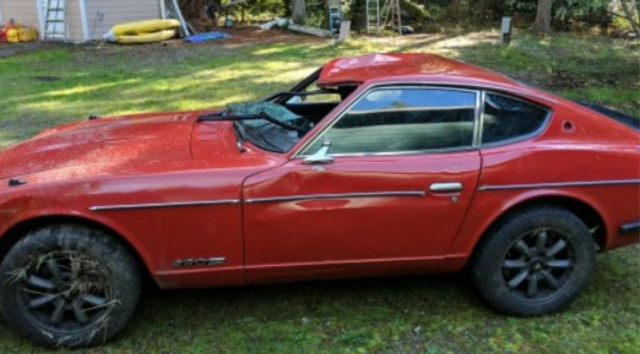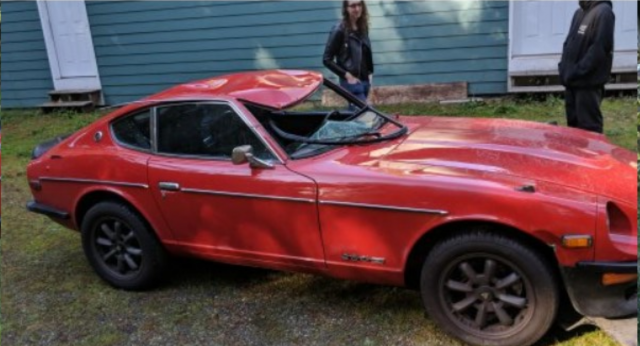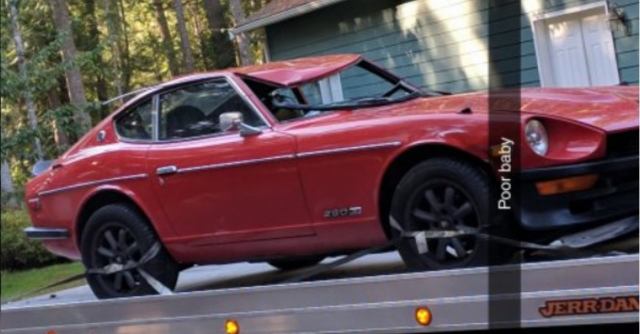Leaderboard
Popular Content
Showing content with the highest reputation on 01/22/21 in all areas
-
1 point
-
Yes I'm getting tired of having to answer the same questions over and over again, so here are some common answers, all in one place and easy to find. I hope that those of you with helpful info to add to this post will reply and do so. Especially those guys that have been through this a few times. This is intended to inform the reader of the options which exist in building up a Nissan L series turbo engine. Specifically to give an overall picture of the cost, potential and problems associated with using this engine as a base for a performance application. Much of this info has been used without permission from various turbo websites, books and discussion forums. This is intended as a guide only. If you follow this to the letter and have a problem, no one is responsible but yourself. Performance Goals The first thing you need to decide is exactly what your goals are. If you hope to have a 200hp L series engine, you likely don't need a turbo. If you want some serious power (200-500+) out of the Nissan L series, using a turbo is probably the most viable option. So You Want a Turbo Now you've decided that you want a turbo L series engine. You have a performance goal in mind and its time to built it! The single most important piece of advice I can give to anyone is to research your build before you do it. (reading this is a good start!) Do yourself a favor, and track down the book "Maximum Boost" by Corky Bell. Read it a few dozen times. By that point, you should know enough about turbo systems to make educated decisions, and to ask the right questions. Also, use the search function here, and scour the internet to see what others have done. At the end of this post there is a list of links to other articles and sites on turbocharging. Some are Nissan specific, some aren't. Now for Some Technical Stuff The best place to start is by getting a 1981-1983 Datsun 280zx Turbo engine. Either with the whole car, or just by itself. If you are planning a stock install, try and get a complete car! There are a whole mess of electronics that you will need from the donor car, AFM, ECU, Wiring harness, fuel pump, etc. The rest of this article is directed more towards a high performance buildup rather than a stock one. I picked up a 1982 280zx turbo engine for around $200US. This included everything physically attached to the engine. It did not include the ECU, fuel pump, airflow meter, etc. This didn't matter to me because from the beginning I was planning to use a different (programmable) system to manage my engine. Time to Get Your Head Checked Well your engines head that is. As you disassemble your engine, be sure to put everything in baggies and label it. This will save you much torture upon re-assembly. Once you get your head off, you might as well send it out to the machine shop. Try to find a shop that specializes in imports, or at the very least has done a few imports before. I sent my P90 head out and had it back in a couple of weeks. Give yourself enough time. If the machine shop quotes you 1 week, expect it in 2-3. For $250US my head got a performance valve job, a complete cleaning, new valve seals, all threads chased and a .010" surface plane. I was quite impressed with the work done to it. Now this is a bit of an optional step, I did a complete rebuilt on my engine, but many people have got great results just using unopened boneyard engines. Your call. Camshafts Remember all those things you heard about putting a hot cam in a performance engine? Forget them all. At least when you are thinking about a turbo. A turbo engine has completely different requirements than a naturally aspirated (NA) engine. For the Nissan L series engine, the stock turbo cam should really do you up to 350-400hp. In general you aren't going to get the same results by putting in a "performance" turbo cam into a turbo engine, as you are when putting a "performance" NA cam into a NA engine. Generally turbo camshafts have a lower valve overlap than NA cams, to prevent exhaust gas reversion. This is caused by the exhaust manifold pressure between the valve and the turbo being higher than the boost (intake manifold) pressure. "Hot" NA cams have quite a large valve overlap, and if these cams are used in a turbo setup you'll end up hurting performance when compared to the stock cam. For over 400hp applications call a cam company and work with them to get the perfect grind of cam for your engine. (custom grind) Porting and Polishing For the less than 400hp crowd you don't really need to port and polish, though a general "cleanup" doesn't hurt. In the past it has been summed up to me like this. "Take the cash you'd spend on porting and polishing and spend it on a better intercooler, better turbo, better engine management, etc" You'll end up with more for your buck this way. The P90 head already flows well. If your goals are over 400hp... I think you should talk to a company that specializes in Nissan L series headwork. (Sunbelt, top end, rebello, etc). You and Your Bottom End So now we head back to your original goals. The general consensus is that Nissan overbuilt these turbo engines. They ran a very cautious 7psi of boost stock. No doubt this was to ensure reliability and long life. I expect that the stock Nissan shortblock (the block, crank, pistons, rods, bearings, etc) can be pushed to a reliable maximum of about 350hp. Anything over that and you are likely throwing reliability into the wind. For a really stout and reliable 300hp+, you should consider going with forged pistons. Pre-detonation can kill a turbo engine by melting pistons and breaking ring lands in under a second. Forged pistons will give you a bit more of a buffer. So be careful setting up your engine, and take it easy until you know your not too lean! If you are planning on an engine with more than 400hp, you will need to do some connecting rod prep as well. One more area of concern, the headgasket. Headgaskets rarely will blow without detonation occurring. If you are going nuts (over 400hp is nuts!) then you should look into block o-ringing or a metal headgasket of some sort. Turbos The stock Airesearch T3 turbo that comes with the 280zxt is decent for probably around the 275hp mark. For more serious power, almost every L28 turbo engine I've heard about uses a T3/T04 hybrid turbo. This uses the stock exhaust side of the turbo and a larger intake impeller. As a result, you can still use the stock exhaust manifold. There are lots of turbo shops in the world, and most can help you decide what is right for you. (plus there are many posts here outlining the same thing) Manifold Choices Honestly, unless you are planning a 450+hp engine, (in which you should be talking a lot to a high performance engine builder) I would stay with the stock exhaust manifold. Headers for turbo cars can run into the $2000 range to have one built. They look really nice though. As far as the intake goes, any L28 series intake will work. (you can use the one that came with the engine) However the earlier intakes (75-78) have a lot less junk attached to them, and a lot less holes. It's worth while to use one of these just to clean things up a bit. But don't panic if you can't get one, I ended up cutting and welding my stock turbo manifold to clean it up. A popular upgrade is to replace the stock throttle body with a 60mm unit. It may not sound like a large improvement, but the 60mm will flow almost 44% more air than the stock 50mm unit. These throttle bodies can be found on many recent cars, such as the Nissan 240sx, which is almost a bolt on mod. You may have to adapt your linkage slightly. Do yourself a favor and once you get the TB, hold it up to the intake and use a Dremel or die grinder to smooth the transition between the 2 pieces. Without doing this, there is no point in upgrading the throttle body! (but make sure you aren't sending aluminum shavings into your engine... remove the intake if possible!) Exhaust Take a look at the stock downpipe coming off the turbo. You'll notice an O2 sensor... and a 90 degree bend, followed by another 90 degree bend. This has to be one of the poorest designed pieces on this engine. I really suggest that you get a custom made downpipe unless you are happy with the stock performance. A good design would be made of 2.5" mandrel bent 304 stainless steel, with 2, 45 degree bends. Alternatively you can have it made out of mild steel and then ceramic coat it. Make sure you know how much room you have before doing this... you don't want to spend the money on a custom piece that won't fit. A 3" downpipe is possible, but makes getting at the bolts to attach it very difficult. As well, the stock T3 outlet is only 2-1/8" diameter. For the exhaust system itself, 3" mandrel bent is the only way to go. (no press bends) The less exhaust restriction you have, the faster your turbo will spool up, and the less lag you will have. Again, forget about traditional concerns such as backpressure, and loss of torque with a bigger pipe, those rules don't apply to turbos. Zero restriction is perfect, but loud. A 3" system will give you excellent flow when used with a high flow muffler. Don't use a resonator in this system! The turbo itself will eliminate the exhaust drone that NA 6 cylinders get from 2000-2500 rpm. Turbos will also quiet the exhaust at about 1/3rd the rate a muffler would. Engine Management Big decision. If you are planning on running more than about 275hp, I really wouldn't get stuck on the stock system. This is one area to dish out the cash that you saved by not porting and polishing. For under $1000US you can get a fully programmable system to run your ignition and fuel delivery. If you think you are going to want more power the future, this is the only way to go! It offers nearly infinite flexibility. If you want a stock system, you are on your own to sort through all the wiring diagrams and figuring out which red wire with the gray stripe you need. Sorry. Intercooling This is the other area to dump cash into! A cheap intercooler will take you no where, and do it well. Expect to spend more than $300 for a quality unit. This is the heart and soul of a turbo engine, so do your research well. Spearco offers incredible units, but at a pretty high price. A common performance intercooler is the Isuzu NPR intercooler. They are fairly difficult to find, but if you luck out you can get one used for under $300. Generally when it comes to intercooling a high performance engine you want the biggest intercooler you can find. I wince a little when I say that. A good design is more important than the size of the unit. Read up on what makes a good intercooler and make an educated choice. Fuel Delivery First thing, you'll likely want a new fuel line if you plan on pushing 300hp. I expect a 3/8" feed line would provide enough flow for a 350hp car. 5/16" is a good size for a return line. You are also going to need a high pressure fuel pump. New ones are nice, but if you want to go used try to get one out of a high performance car with a larger displacement than 2.8liters. Something like a BMW 535, 635, 735 could do. A 300zxtt, Supra tt, etc. would likely also do. Depends how wild you want to go. While you are wiring in your new fuel pump (make sure you use a relay for it) now is a good time for a little theft protection. Run a hidden toggle switch on the line that triggers your fuel pump relay. As long as you remember to turn it off every time you get out of the car, it's a pretty decent way to keep your car where you left it. Injectors Those stock injectors aren't gonna cut it over 250hp. You can cheat a little by running higher than stock fuel pressure through them, but this is just a band-aid fix. A common OEM injector that can support around 300hp is the Ford Merkur/SVO injectors. They are considerably cheaper than high performance injectors, and will fit in the Z with some modifications. Beware, you're going to need a custom fuel rail if you go this route. (Which again will clean up the look of your engine) Blow Off Valve This modification is highly recommended on any turbo Z car. When the throttle plate closes the air is still being pushed out of the turbo, it hits the throttle plate and reverses towards the turbo impeller. This collision causes the turbo to slow down spinning. Which means that every time you shift gears the turbo will slow down its spin. Not good! Adding a simple blowoff valve between the turbo and the throttle body will drastically improve this problem. You can spend $200 and get one from Greedy, (Greddy) or you can go to the wreckers and try to locate on off a Talon/Eclipse/Laser Turbo from '90-94. $20 or so and it should be yours. Wastegate and Boost Control The stock wastegate on the T3 turbo is pretty decent. In the pages listed below you can see 2 different methods of controlling your boost levels. One way is by metering the vacuum signal to the wastegate, and the other way is by threading the wastegate rod and changing the length of it. An external wastegate is a superior design to this integrated design. If you are planning high boost (over 15psi) you will probably want to design a external setup. Maximum Boost has a great section on wastegate design. Oil This is an often debated topic. I strongly suggest that anyone building up a turbo engine plan to run fully synthetic oil for the life of the engine. Synthetic oil is simply going to stand up better to the high heat that oil sees in turbocharged engines. If you absolutely will not run synthetic for some reason, try to use a straight weight motor oil. These oils are more stable than the multiweight (such as 10W-30, 20W-50) oils. This stability helps prevent oil 'coking' which is a common cause of turbo failure. However, you don't want to use synthetic motor oils for the break in period. They simply lubricate too well to allow your engine to go through the proper break in cycle. Also, its generally recommended that you change your oil every 500miles during break in. That gets mighty expensive if running synthetic. Budget You'll notice that a lot of the advice in this article revolves around how to make a low budget, high performance turbo engine. It really shouldn't be difficult to have a 300hp engine for around $3500. Use some creativity and search autowreckers for OEM parts that may work. (such as the Isuzu NPR intercooler, eclipse BOV, Merkur/Svo injectors) Take the time to research your product before you buy and you will save yourself money. There is nothing worse than paying top dollar for a part that you don't need! Recommended Internet Reading: http://home.flash.net/~joeao/greg/zcar.html http://www.eng.fsu.edu/~jthagard/ http://www.sdsefi.com (Good tech articles here) http://www.stealth316.com/1-tech.htm http://www.geocities.com/z_design_studio/transmission.html http://www.zhome.com/ZCMnL/tech/turbo.html1 point



